Paris Saint-Germain suffered a second straight 1-0 Ligue 1 loss in their second game of the 2020/21 season this past Sunday as Olympique de Marseille emerged triumphant from the new season’s first instalment of ‘Le Classique’ – Ligue 1’s answer to La Liga’s ‘El Clasico’ clash between Real Madrid and Barcelona.
While this fixture condemned Les Parisiens to their second straight loss, leaving them in 18th place in the Ligue 1 table after just two games, Sunday’s Parc des Princes win gave Marseille their second straight victory of the new season and leaves them in fifth place in the league table after playing one less game than three of the four teams sitting above them at present.
In this tactical analysis piece, we will look at both of these sides’ tactics from this past Sunday’s game, both in and out of possession. We will provide analysis of some of the key aspects of both these teams’ tactics from Sunday’s fixture and look at how Marseille kept PSG quiet while examining how Paris attempted to break down a stubborn Marseille defence.
Lineups and formations
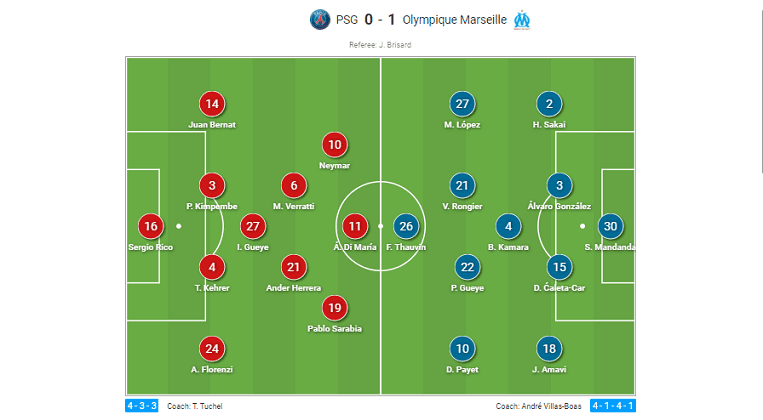
Firstly, we will look at how both of these teams lined up for Sunday’s Le Classique. Sergio Rico started between the sticks for the home side in this game, with a back four of left-back Juan Bernat, right-back Alessandro Florenzi and the centre-back duo of Thilo Kehrer and Presnel Kimpembe playing in front of the Spanish ‘keeper.
In midfield, Idrissa Gueye was joined by Marco Verratti and Ander Herrera, while the attacking trio of Pablo Sarabia, Ángel Di María and Neymar made up the rest of Thomas Tuchel’s starting XI.
PSG set up in a base 4-3-3 shape for this contest, however, they often played in a shape that much more closely resembled a 4-2-3-1, both during the build-up phase and when out of possession, with Herrera occupying a more advanced role and PSG’s other two central midfielders playing slightly more withdrawn, on occasions.
As for the away side, André Villas-Boas set his team up in a 4-1-4-1 shape for this fixture. Les Olympiens’ captain Steve Mandanda started in goal, while the back four in front of him consisted of left-back Jordan Amavi, right-back Hiroki Sakai and the central defensive pairing of Duje Ćaleta-Car and Álvaro González.
Boubacar Kamara played in the holding midfield role just between the back four and the midfield four. In midfield, Dimitri Payet played on the left, Maxime Lopez played on the right and the duo of Pape Gueye and Valentin Rongier made up the rest of the midfield.
Lastly, Marseille started with Florian Thauvin as their most advanced attacker in this fixture and he operated in a slightly withdrawn ‘false 9’ role for much of this contest.
PSG in attack
We’re going to kick off the tactical analysis portion of this piece by looking at how Thomas Tuchel’s side played in possession of the ball and first, we’ll look at how they played during the build-up from their goal-kicks.
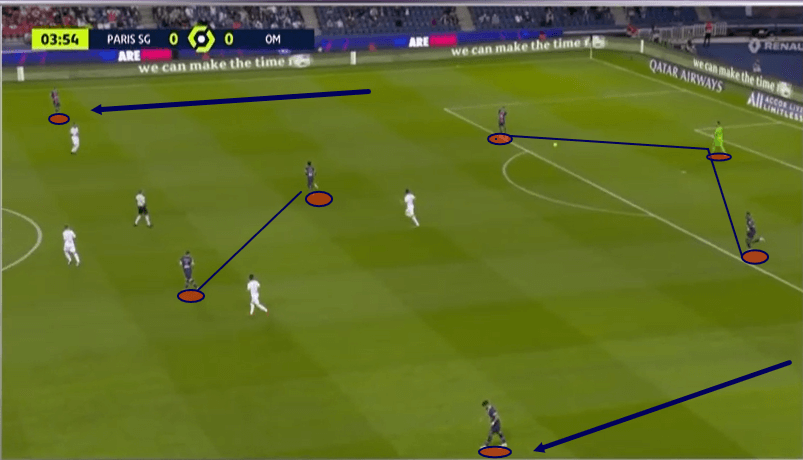
This image above shows us an example of PSG’s shape during the early stages of an attack. Here, we can see Les Parisiens’ central defensive pairing of Kehrer and Kimpembe both sitting just on the edge of the box providing short passing options for goalkeeper Rico.
PSG’s centre-backs usually weren’t put under a great deal of pressure, particularly during the build-up, and as a result, from here, they generally had plenty of time and space to decide on their next move, which was usually either a pass into one of the two deeper central midfielders – Gueye and Verratti – or a pass out wide to one of the two PSG full-backs.
As Marseille didn’t press particularly high up the pitch, PSG’s centre-backs generally had plenty of time with the ball at their feet and as a result, their quality on the ball and their choices of pass were important in this contest.
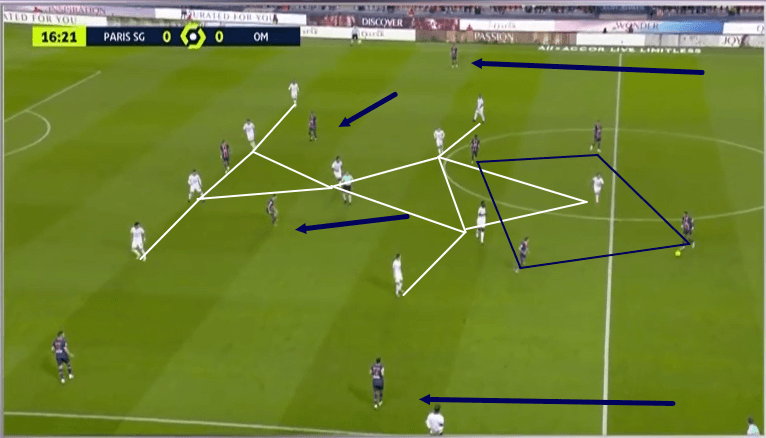
This next image shows us an example of PSG’s centre-backs in possession of the ball in a slightly more advanced stage of the attack, with Paris just on the verge of playing the ball into Marseille’s half of the pitch here. As we can see, there still isn’t a great deal of pressure being applied to the PSG centre-backs, despite the fact that they are in possession of the ball much higher up the pitch here than they were going to be in the previous image.
With PSG dominating the possession in this game, ending the contest having kept a total of 65.05% of the possession, this image provides us with a good example of both of these teams’ typical respective shapes in this game.
As for Paris, we can see that in addition to their centre-backs having plenty of time and space, they also enjoyed plenty of space out wide. Throughout this contest, the main theme to their attacking game was to try and exploit this space out wide and threaten Marseille’s box through these positions. This put a lot of the attacking onus on the overlapping runs of Florenzi and Bernat, while the two full-backs’ crossing ability was also put to the test frequently during this contest.
Additionally, PSG deployed a fairly fluid front three during this contest and Sarabia, Neymar and Di María all ended up occupying wide positions at times. One way in which Les Parisiens did manage to threaten the Marseille goal during this fixture was via these attackers deep runs cutting inside from the wings.
Those players thrived when given space out wide and while Marseille’s full-backs did attempt to stay tighter to them when receiving the ball in these positions, the visitors’ defensive shape ultimately did offer PSG plenty of space in these areas which the hosts could exploit and Paris did, almost exclusively, attack through these areas of the pitch during this fixture.
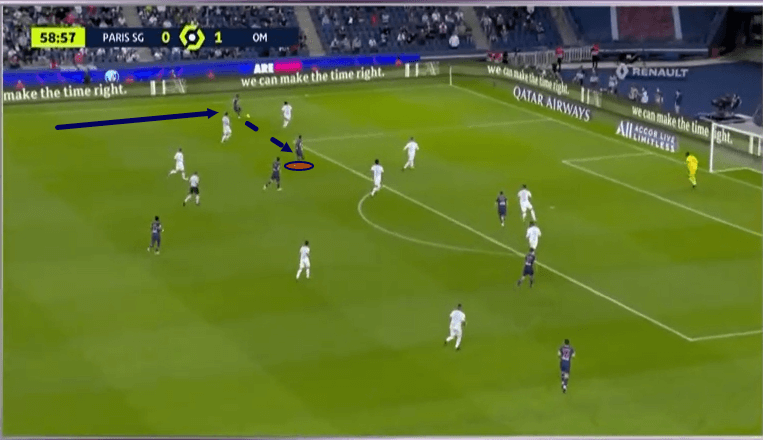
Another way that PSG tried to use the wide areas to get themselves into a position where one of their front three could attack the goal, is by positioning those players in the half-space and playing the ball into them via an overlapping full-back whose run would, ideally, pull the Marseille full-back out of the defensive line, creating space, as it did in the image above.
Here, Bernat can be seen in possession of the ball, having carried it forward from a slightly deeper part of the pitch, while Neymar can be seen in the half-space. Bernat’s run attracts pressure from Sakar, whose movement out wide creates space for Neymar in this slightly more central position.
The Spanish left-back slides the ball into the Brazilian attacker, who manages to get a shot off from this position.
Usually, as we will discuss at greater length later on in this tactical analysis, Marseille’s full-backs were quite reserved about pressing out wide like this and tended not to venture too far outside of the penalty box, particularly when one of PSG’s front three were in a more central position, however, on this occasion, the full-back was successfully drawn away from his position and Marseille very nearly paid the price for allowing this gap in their defensive line to be created, as one of Sarabia, Neymar and/or Di María possess enough technical ability to create a goalscoring opportunity if found in any space at all in and around the box.
This is likely why Marseille’s full-backs usually stayed deep and narrow, and this particular passage of play provides us with an example of how dangerous it can be if these PSG attackers are allowed space in this part of the pitch, which is something that Tuchel’s side tried, much of the time unsuccessfully, to exploit in this one.
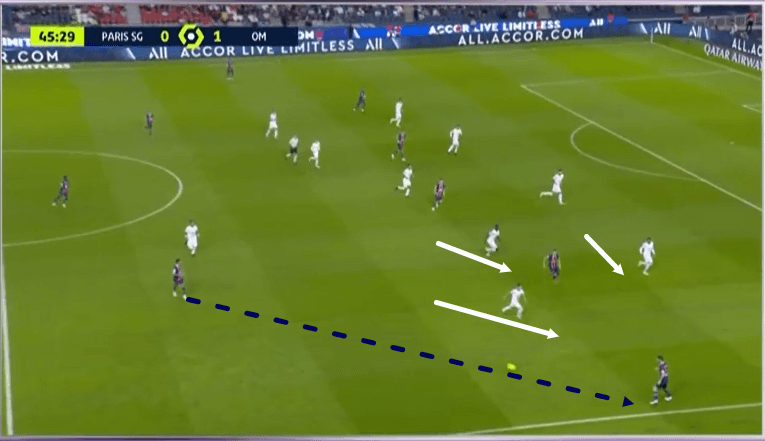
In order to try and get into crossing positions high up the pitch, PSG’s full-backs first had to receive the ball and this task of finding the wide men in space was usually the responsibility of either the PSG centre-backs or one of Gueye or Verratti, who would drop deep at times so that they could use their technical ability to advance play with more space than they were afforded further up the pitch.
As we saw previously in this tactical analysis piece, PSG’s full-backs were given a lot of space to overlap out wide and ideally, they would receive the ball via a pass played in front of them so that they could run onto the ball and immediately carry it forward, without having to wait to receive it.
However, on occasion, the full-backs weren’t supplied the ball in this ideal way. The image above shows us an example of Kehrer playing the ball out to Florenzi, however, the pass is played to Florenzi’s left-foot, as opposed to his right, meaning that he has to turn his body to face the oncoming pass and wait for it to arrive, rather than being able to receive the pass while facing the Marseille goal and being able to meet it head-on.
In addition to holding up the full-back, this kind of pass allowed Marseille’s defence to re-organise and shift over to this part of the pitch in order to quickly restrict the space that the full-back enjoys and as this passage of play moves on, Florenzi is forced to play the ball straight back to Kehrer.
This is one example of how the distribution from PSG’s centre-backs, at times, could have been better, because if this pass had been played in front of Florenzi, he could have continued to advance the play and instead, he was forced to go backwards.
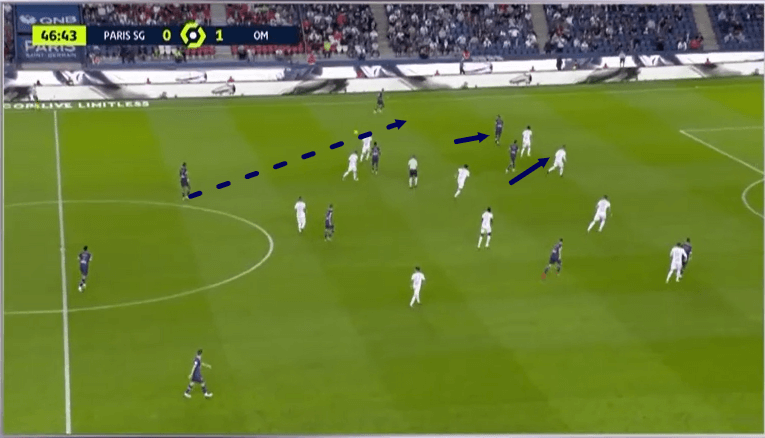
This next image shows us the opposite, in that here, we can see Kimpembe finding Bernat’s overlapping run well with a pass played in front of the Spaniard. As we can see, Bernat didn’t need to turn and face the defender to receive the pass and instead can continue his run.
This allows him to continue to move in behind Marseille’s defensive shape as he receives the ball and as this passage of play moves on, he quickly manages to find Di María who runs in behind in the channel between the right centre-back and the right-back.
This shows the importance of the quality of the distribution from the centre-backs and how it can quickly make the difference between the ball ending up with one of PSG’s dangerous front three in the exact position that their gameplan was set-up to get them into, and the ball remaining with the central defenders at square one.
Marseille’s defence
As we saw in the previous section of this tactical analysis piece and as we’ve mentioned previously, Marseille lined up in a 4-1-4-1 shape without the ball. They didn’t press extremely aggressively, instead opting to protect the deeper areas of the pitch while sitting in a very vertically and horizontally compact mid-low block.
The story of this game, largely, was Marseille’s deep compact block and PSG’s unsuccessful attempts at penetrating it. Les Olympiens’ defensive shape did give up plenty of space out wide, as we’ve touched on, and Paris did try desperately to use that to their advantage during the game, whilst also trying to find one of their three main attackers in the half-spaces, however, Marseille’s defensive tactics ultimately prevailed and shut out the home side.
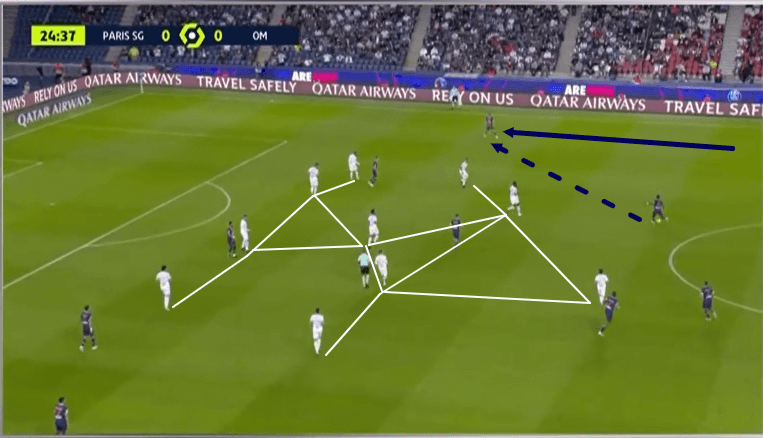
The image above shows us a clear example of Marseille’s 4-1-4-1 shape, its narrow nature and the space it gave up on the wings. Even when PSG were in possession of the ball inside Les Olympiens’ half of the pitch, they sat in this same compact shape, marking zonally and giving up this space for the PSG full-backs to try and exploit out wide.
One potential reason for this was the fact that PSG lacked a great deal of aerial presence up front, between Sarabia, Neymar and Di María and Marseille may have fancied their defenders’ chances at beating them in the air once the crosses from the overlapping full-backs inevitably came in. While PSG did get onto the end of a couple of high crosses, Marseille were generally quite successful at defending against the PSG wide men’s playmaking attempts.
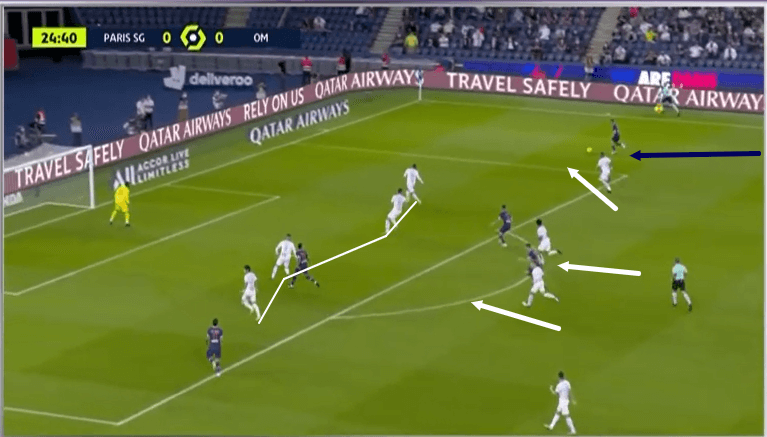
As this particular passage of play moves on, we see that Marseille’s back four remains compact and central, including the near-side full-back, despite Florenzi advancing down the wing into a threatening position in possession of the ball.
Rather than taking a man out of the penalty box to close him down, Marseille generally retained all four defenders inside the box in order to crowd out this area and ultimately defend the cross after it had been played, rather than trying to prevent it from coming in.
The near-side winger would usually drop deep, temporarily acting as an auxiliary wing-back, in order to apply some pressure to the advancing full-back. We can see Payet performing this role in this particular passage of play.
PSG did threaten the Marseille goalmouth on a couple of occasions, in particular via low crosses driven at pace across the face of goal, however, all in all, Marseille’s defensive tactics of retaining their back four in deep central positions, while giving up space out wide was a successful tactic in this game and limited PSG’s offensive options.
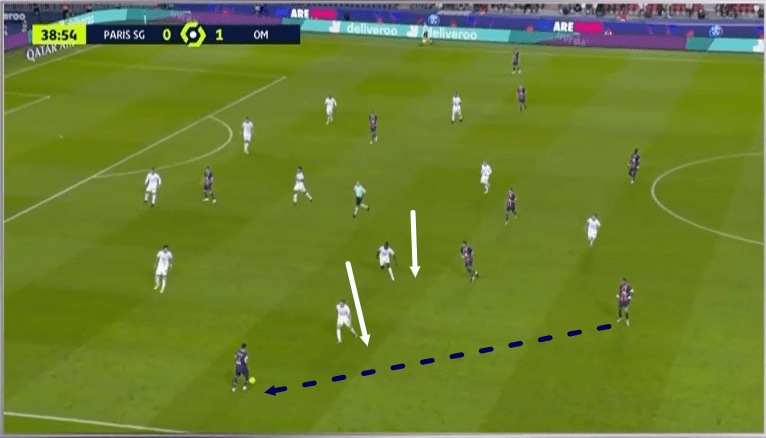
Marseille tried to force PSG out wide during this game and this image above provides us with an example of the away side doing just this. As we’ve established, Les Olympiens defended in a narrow, compact block and gave up space out wide, as a result, PSG often built up their attacks by playing passes from the centre-backs to the high, wide full-backs, as was the case in this particular passage of play.
As Bernat received the ball here, Marseille’s near-side winger presses him on the outside, the near-side centra- midfielder shifts over to provide cover while marking the nearest PSG midfielder, while the near-side full-back stays deep and narrow, not opting to press the ball receiver.
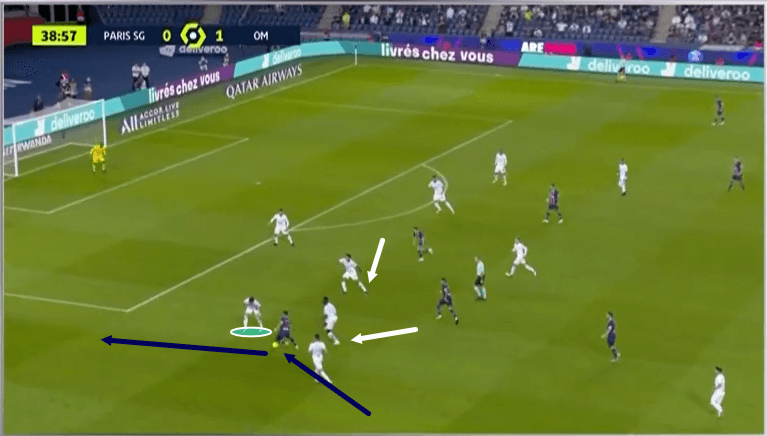
This leaves the full-back with a clear pathway down the left-wing and not many other viable options and as this image above shows us, the left-back ultimately ended up carrying the ball down the wing, as Marseille had, essentially, arranged.
As Bernat advanced forward, Sakai, the near-side full-back maintains his position and the other Marseille men we had previously mentioned continued to close in on the player, essentially creating a triangle around him with the only opening being a pathway out wide down the left-wing.
Bernat ultimately was forced to take up this option to retain possession of the ball and once he made his move down this pathway, then Sakai successfully forced him to drive the ball out of play.
This passage of play shows us another way that Marseille used the open space out wide to nullify PSG’s attacking threat during this fixture. Les Olympiens ultimately used this space out wide to their advantage off the ball throughout this contest in these two ways, in particular, and their successful use of this space played a huge role in their win on Sunday.
PSG’s defence
Off the ball, PSG pressed their opponents high up the pitch in this game, starting from Marseille’s goal-kicks and attempts to build out from the back.
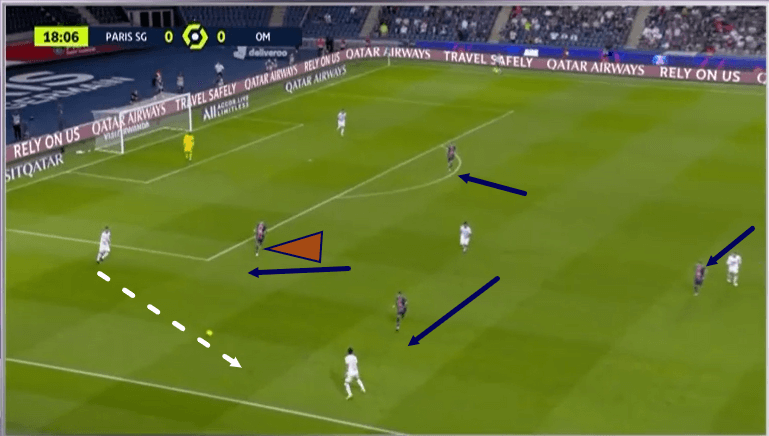
This image above provides us with an example of PSG’s shape off the ball for a Marseille goal-kick. Les Parisiens deployed a man-oriented press in this contest, which we can see in action here.
Just prior to this image being taken, Mandanda played the ball out to his right centre-back – González. As González received the ball the PSG player nearest to him took up a position in between the Marseille centre-back and the Marseille holding midfielder Kamara.
Meanwhile, another PSG forward maintained access to González’s central defensive partner Ćaleta-Car while another PSG man maintained access to the right-back Sakai, who we can see receiving possession from the central defender here.
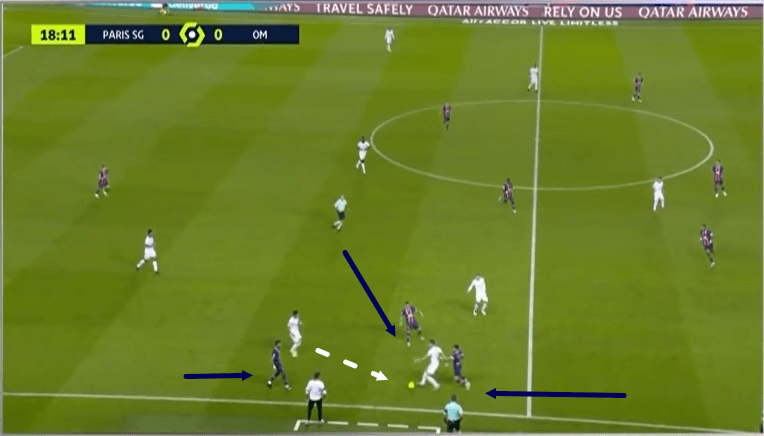
As Sakai receives the ball, he is pressured and then quickly advances it up the pitch to find Marseille’s right-winger, Lopez. As Lopez receives the ball, however, Bernat gets tight to him, preventing him from turning, while one PSG player follows Sakai, essentially blocking off that passing option and another PSG player shifts from the centre into the passing lane between Lopez and the nearest Marseille central midfielder.
On this particular occasion, Lopez did actually manage to squeeze the ball through the gap between two of these PSG players to find the nearest central midfielder but he too was quickly put under pressure, forced to play the ball back out to the wing and Paris ended up regaining possession not long after the ball was played into their half of the pitch, demonstrating the effectiveness of their aggressive, man-oriented style of pressing in preventing Marseille from building up via short passes from the back.
Les Olympiens tended to play the ball long from the back far more often in this contest due to the effectiveness of PSG’s high press.
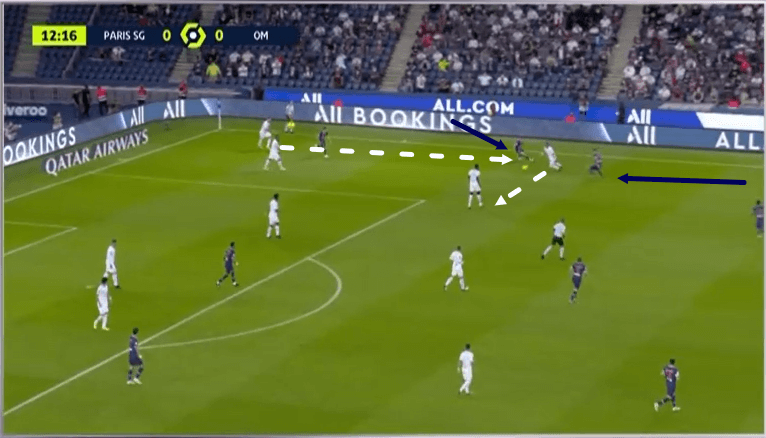
PSG also deployed an effective counter-press in this fixture and we can see an example of this in this next passage of play, starting with this image above. Just prior to this image being taken, PSG had been advancing down the right-wing, before they were dispossessed and after his side regained possession in this deep position, Payet quickly found himself on the ball, as this image above shows.
Similarly to the previous passage of play which showed Marseille’s attempt at building out from the back, Payet was quickly put under pressure by a PSG player who prevented him from turning and facing the opposition’s half of the pitch.
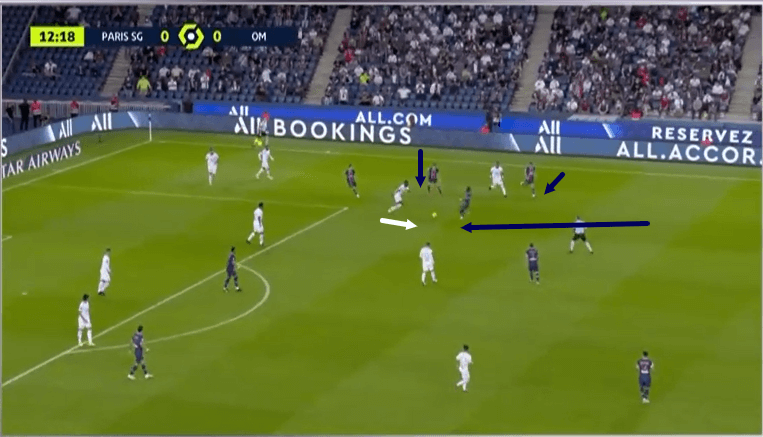
The winger managed to play the ball inside to Pape Gueye, which was a pass that PSG had left open, however, as the midfielder received the ball and turned to face the opposition half of the pitch, Idrissa Gueye was there to meet him.
The PSG midfielder quickly and aggressively advanced from his deeper position to join his side’s counter-press. He put his ball-winning quality to good use and swiftly dispossessed the Marseille man in a dangerous position, helping his side to thwart this Marseille counter-attack attempt and kickstarting a dangerous counter-attack for his team in the process.
Considering how effective their pressing and counter-pressing was in this contest, and knowing how much they struggled to break down Marseille when the away side were settled in their regular 4-1-4-1 defensive shape, it might be arguable that PSG were at their most dangerous offensively when pressing high in this game, however, Marseille didn’t often give them the opportunity to do so as they tended to play it safe more often than not, making these high pressing opportunities rare for Les Parisiens.
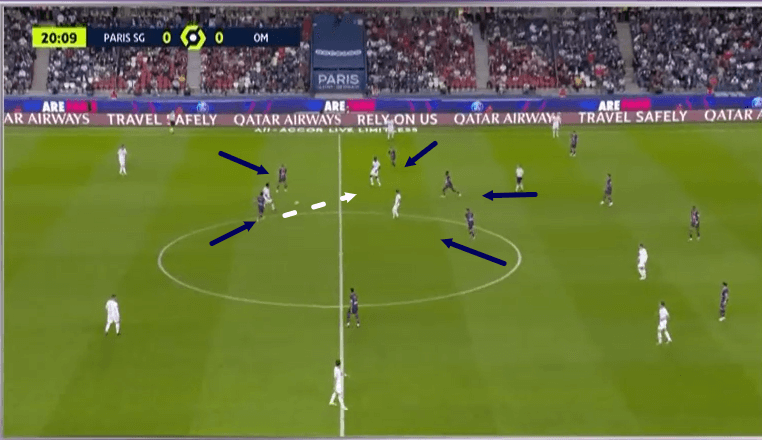
While the previous images showed us how PSG made it difficult for Marseille to build attacks against them via the wings, Paris’ defensive tactics also made it difficult for Les Olympiens to build attacks through the centre during Sunday’s game.
The image above shows us an example of Kamara playing the ball into one of his two more advanced central midfielders, Gueye, however, as Gueye receives the ball, this triggers an aggressive press which sees Paris players close in on him and his nearest progressive passing options.
The midfielder is prevented from turning due to this pressure, while the passing options out to the wing and into his central midfield partners are all essentially blocked off. The midfielder does well to retain possession and quickly play the ball back to the central defender, however, this passage of play provides us with another example of PSG’s well-drilled pressing tactics out of possession and how effective they were at preventing Marseille from building attacks via short passes.
Marseille in attack
In contrast to the home side, and partly due to the effectiveness of their opponent’s pressing, as we discussed in the previous section of this tactical analysis, Marseille tended to play the ball long from the back quite often. However, they utilised a couple of notable strategies via these long-balls from the back.
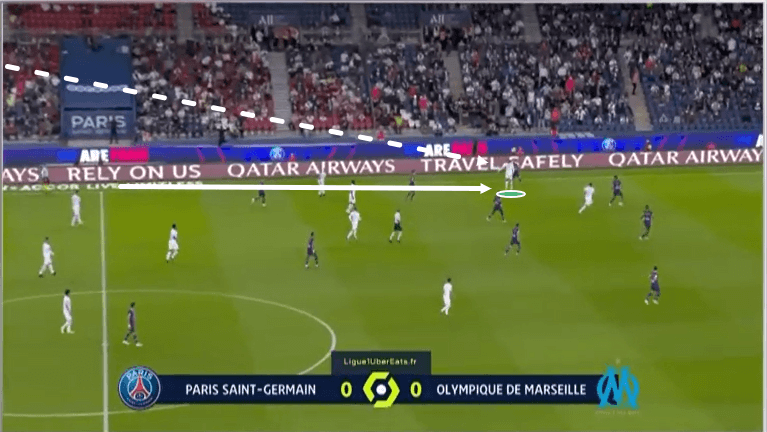
This image above provides us with one example of a Marseille long-ball from a Mandanda goal-kick in this past Sunday’s contest. We can see that this particular long-ball was directed towards the left-wing, where it was met by Marseille’s left-back Amavi, who had advanced from his base position at the left of the back four to take up this position in the offensive line in order to contest and win, this aerial duel.
This tactic of playing the long-ball with the intended target being an advancing Amavi was utilised on a couple of occasions during this game.
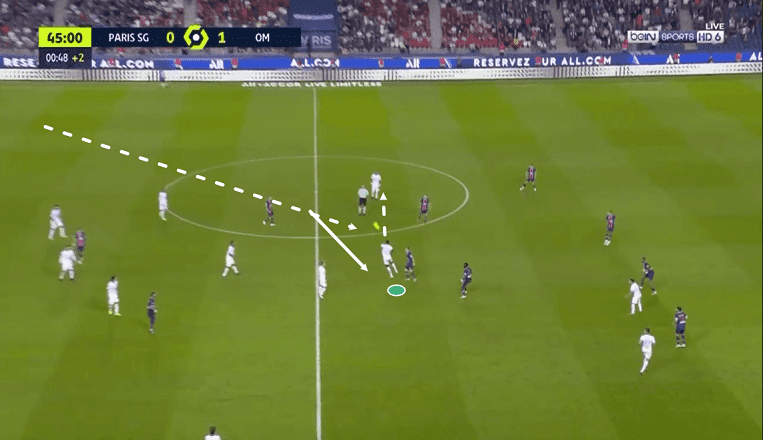
Additionally, 189cm (6’2”) tall Pape Gueye represented another long-ball target for Les Olympiens on a couple of occasions in this fixture.
Gueye’s height was helpful in aiding Les Olympiens to build attacks from the back, as he could beat Verratti and Idrissa Gueye in the air, both of whom are considerably shorter than him.
In this particular image above, the Marseille man had shifted over to the right side of midfield in order to position himself to contest this aerial duel with 165cm (5’5”) tall Verratti. The Marseille midfielder managed to easily get onto the end of Mandanda’s long-ball thanks to his intelligent positioning and obvious physical advantage and he knocked the ball out to Les Olympiens playmaker Payet, who could then keep this Marseille attack going.
So, while Les Olympiens struggled to build attacks via short passes front he back due to PSG’s quality pressing, they did find ways around this in order to build some attacks regardless and get around Paris’ high press.
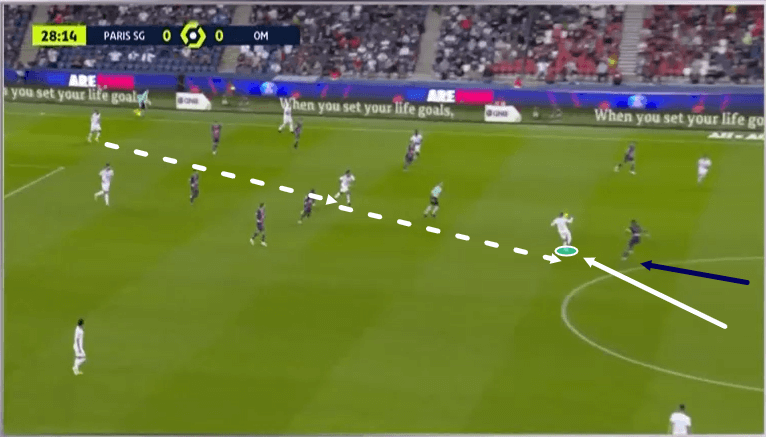
Villas-Boas’ decision to play Thauvin in a central attacking position in a false 9 role also helped Marseille to build their attacks at times, particularly during counter-attacks. As we touched on in the previous section of this tactical analysis, Marseille struggled to build counter-attacks due to PSG’s aggressive and effective counter-pressing.
However, as PSG’s attackers and midfielders pressed high during counter-pressing periods, this created space for Thauvin to drop deep into and potentially exploit, which he did in this particular passage of play being displayed in the image above.
After regaining possession and playing around with the ball in their backline for a short while, Marseille played the ball from the back into the midfield and then Thauvin quickly found himself in possession of the ball. As he received the ball he attracted pressure from PSG centre-back Kimpembe, who closed the attacker down in the absence of his side’s midfielders, who were pressing higher.
On this occasion, a combination of a struggle with controlling the ball in time and Kimpembe’s pressure prevented Thauvin from progressing the ball once more to challenge PSG’s weakened defence on the counter, however, this passage of play does show us how useful Thauvin was as someone who his side could use as an outlet to play through on the counter, while we can also see how his movement created space for his teammates in central positions by pulling Kimpembe away from the PSG backline.
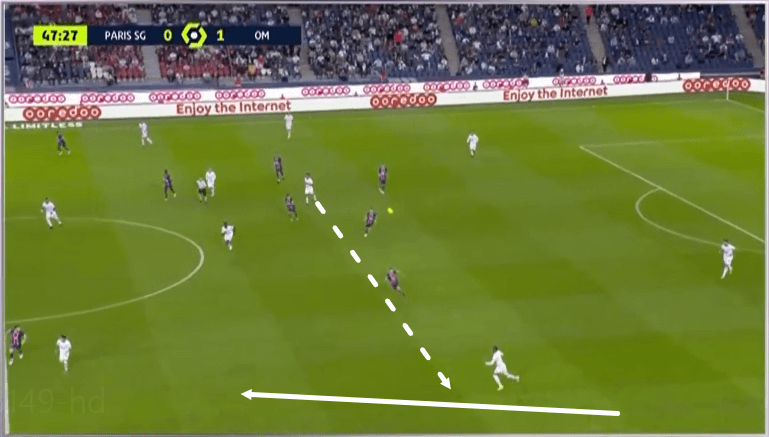
Lastly, Marseille’s full-backs were constantly driving forward and making overlapping and underlapping runs in this game and they played an important role in Marseille’s offensive tactics versus PSG.
In this image above, we can see Marseille’s Kamara playing the ball across the field to find Amavi who is in the process of advancing from the left-back position into a slightly more central position.
This run from the wide left-back position is one that Amavi made frequently throughout this game, often as an underlapping run while left-winger Payet dropped into a slightly deeper, wide playmaking position, however, on this occasion, we can see that the full-back is advancing into this position with the intention of meeting the ball and carrying it forward himself.
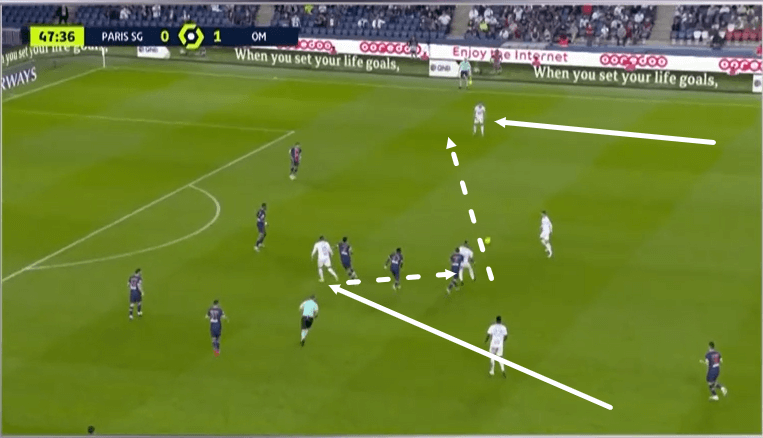
As this next image shows, this is exactly what Amavi does. He managed to control the ball very well and subsequently carry it forward into the opposition half of the pitch, via some impressive dribbling ability.
The left-back ends up as Marseille’s most advanced player by the time he completes his run forward and after playing a quick pass onto a supporting teammate in the centre, the ball ends up being played out to right-back Sakai, who made an overlapping run on the right-wing while left-back Amavi was carrying the ball forward himself from the opposite side of the pitch.
This passage of play shows us the important role that both Marseille full-backs played in their side’s offensive tactics on Sunday. As we can see, Amavi’s ball-carrying ability helped his side with breaking into PSG’s half of the pitch, while both full-backs produced runs like the one Sakai made here which provided width and gave Les Olympiens options in the final third.
Conclusion
To conclude this tactical analysis piece, both teams’ tactics led to this game centring around PSG’s attempts at exploiting the wings and Marseille’s focus on protecting the deep, central areas of the pitch, which they were ultimately successful at doing. 7
PSG’s pressing and attempts to find their attackers in the half-spaces were also major aspects of this game, as was Marseille’s more direct build-up and their counter-attacking attempts.





Comments